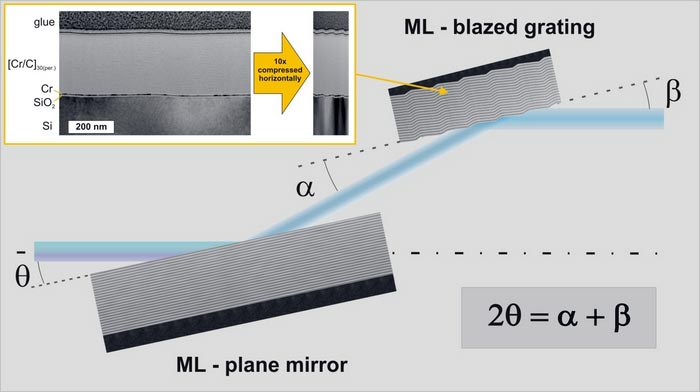New monochromator optics for tender X-rays

Keywords: energy (407)user research (66)Catalysis (15)HZB own research (221)materials research (155)BESSY II (390)quantum materials (80)life sciences (90) Science Highlight 30.11.2022 New monochromator optics for tender X-rays Schematic drawing of the novel monochromator concept at the U41-PGM1 beamline at BESSY-II based on a multilayer coated blazed plane grating and mirror to improve the photon flux in the tender X-ray photon energy range (1.5 – 5.0 keV). The inset shows a TEM image of the cross-section of the Cr/C multilayer blazed grating structures. For better visualization of the grating period, the image was horizontally compressed 10 fold. Schematic drawing of the novel monochromator concept at the U41-PGM1 beamline at BESSY-II based on a multilayer coated blazed plane grating and mirror to improve the photon flux in the tender X-ray photon energy range (1.5 – 5.0 keV). The inset shows a TEM image of the cross-section of the Cr/C multilayer blazed grating structures. For better visualization of the grating period, the image was horizontally compressed 10 fold.
Credit: HZB / Small Methods 2022
Until now, it has been extremely tedious to perform measurements with high sensitivity and high spatial resolution using X-ray light in the tender energy range of 1.5 – 5.0 keV. Yet this X-ray light is ideal for investigating energy materials such as batteries or catalysts, but also biological systems.
A team from HZB has now solved this problem: The newly developed monochromator optics increase the photon flux in the tender energy range by a factor of 100 and thus enable highly precise measurements of nanostructured systems. The method was successfully tested for the first time on catalytically active nanoparticles and microchips.
A climate-neutral energy supply requires a wide variety of materials for energy conversion processes, for example catalytically active materials and new electrodes for batteries. Many of these materials have nanostructures that increase their functionality. When investigating these samples, spectroscopic measurements to detect the chemical properties are ideally combined with X-ray imaging with high spatial resolution at the nanoscale.
However, since key elements in these materials, such as molybdenum, silicon or sulphur, react predominantly to X-rays in the so-called tender photon energy range, there has been a major problem until now.
This is because in this “tender” energy range between soft and hard X-rays, conventional X-ray optics from plane grating or crystal monochromators deliver only very low efficiencies. A team from HZB has now solved this problem: “We have developed novel monochromator optics. These optics are based on an adapted, multilayer-coated sawtooth grating with a plane mirror,” says Frank Siewert from the HZB Optics and Beamlines Department.
The new monochromator concept increases the photon flux in the tender X-ray range by a factor of 100 and thus enables highly sensitive spectromicroscopic measurements with high resolutions for the first time. “Within a short time we were able to collect data from NEXAFS spectromicroscopy on the nanoscale. We have demonstrated this on catalytically active nanoparticles and modern microchip structures,” says Stephan Werner, first author of the publication. “The new development now enables experiments that would otherwise have required months of data collection,” Werner emphasises.
“This monochromator will become the method of choice for imaging in this X-ray energy range, not only at synchrotrons worldwide, but also at free-electron lasers and laboratory sources,” says Gerd Schneider, who heads the X-ray Microscopy Department at HZB. He expects enormous effects on many areas of materials research: Studies in the tender X-ray range could significantly advance the development of energy materials and thus contribute to climate-neutral solutions for electricity and energy supply.
Journal: Small Methods
DOI: 10.1002/smtd.202201382
Method of Research: Experimental study
Subject of Research: Not applicable
Article Title: Spectromicroscopy of nanoscale materials in the tender X-ray regime enabled by a high efficient multilayer-based grating monochromator
Article Publication Date: 30-Nov-2022
COI Statement: none
Media Contact
Antonia Roetger
Helmholtz-Zentrum Berlin für Materialien und Energie
antonia.roetger@helmholtz-berlin.de
Office: 0049-308-062-43733
Media Contact
All latest news from the category: Materials Sciences
Materials management deals with the research, development, manufacturing and processing of raw and industrial materials. Key aspects here are biological and medical issues, which play an increasingly important role in this field.
innovations-report offers in-depth articles related to the development and application of materials and the structure and properties of new materials.
Newest articles
Faster, more energy-efficient way to manufacture an industrially important chemical
Zirconium combined with silicon nitride enhances the conversion of propane — present in natural gas — needed to create in-demand plastic, polypropylene. Polypropylene is a common type of plastic found…

Energy planning in Ghana as a role model for the world
Improving the resilience of energy systems in the Global South. What criteria should we use to better plan for resilient energy systems? How do socio-economic, technical and climate change related…

Artificial blood vessels could improve heart bypass outcomes
Artificial blood vessels could improve heart bypass outcomes. 3D-printed blood vessels, which closely mimic the properties of human veins, could transform the treatment of cardiovascular diseases. Strong, flexible, gel-like tubes…





















